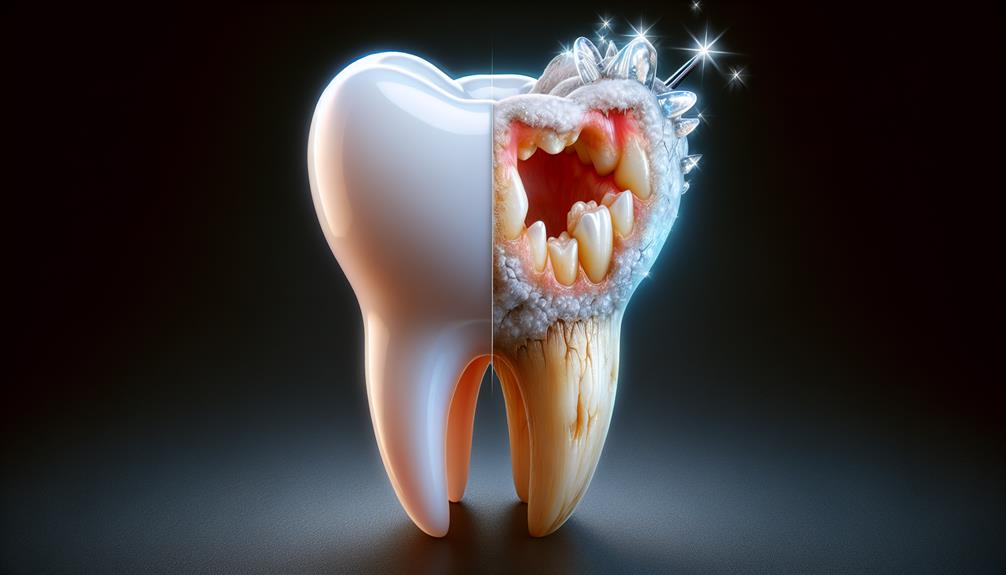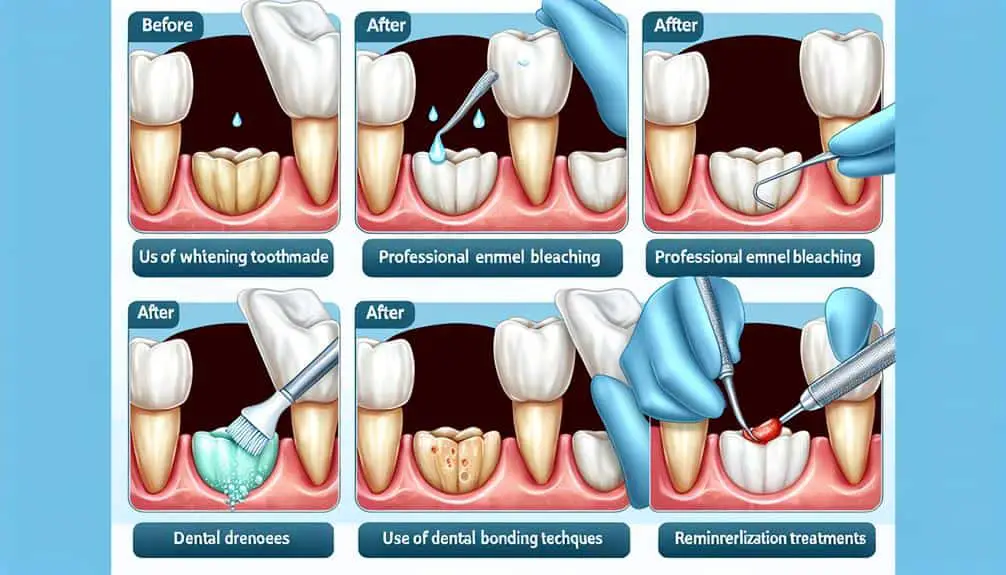When whitening your teeth, opt for enamel-friendly systems to safeguard your enamel from damage caused by some whitening products. Enamel is essential for protecting your teeth, preventing sensitivity and decay. By choosing enamel-safe products like those with fluoride, you fortify your enamel and promote long-term oral health. These systems help reduce tooth sensitivity and the risk of cavities, ensuring your smile stays healthy. Learn how to keep your enamel strong and your teeth white with enamel-friendly whitening options.
Key Points
- Enamel-friendly systems protect enamel from weakening during whitening.
- These systems help maintain enamel strength for overall oral health.
- Choosing enamel-safe products minimizes the risk of enamel damage.
- Enamel-friendly products reduce sensitivity and promote enamel remineralization.
- Long-term enamel health is ensured by using enamel-friendly whitening systems.
Importance of Enamel Protection
To maintain healthy teeth, it's essential to protect your enamel from damage caused by various factors such as acidic foods and beverages. Enamel is the outer layer of your teeth and serves as a protective barrier. It's critical for enamel to remain strong and intact to prevent enamel sensitivity and decay. Enamel strengthening is important for overall oral health.
Enamel sensitivity occurs when the enamel wears down, exposing the underlying dentin layer. This can lead to discomfort or pain when consuming hot, cold, sweet, or sour foods and beverages. By protecting your enamel, you can prevent or reduce enamel sensitivity. Enamel-friendly habits include using fluoride toothpaste, avoiding acidic foods, and maintaining good oral hygiene practices.
Enamel is a remarkable substance that can withstand a lot, but it isn't invincible. By being mindful of what you expose your teeth to and taking steps to strengthen your enamel, you can maintain a healthy smile and prevent enamel sensitivity.
Impact of Whitening on Enamel
When considering teeth whitening systems, it's important to understand the potential impact they may have on the protective enamel layer of your teeth. Enamel, the outermost layer of your teeth, plays a critical role in protecting your teeth from decay and damage. Whitening products contain ingredients like hydrogen peroxide that can penetrate the enamel to break apart stains. While this enhances the whitening effectiveness, it can also temporarily weaken the enamel.
Enamel strength is essential for maintaining good oral health. Weakened enamel may lead to increased sensitivity and susceptibility to damage. It's crucial to choose whitening systems that are enamel-friendly to minimize any negative impact. Look for products that are formulated to be gentle on enamel while still effectively whitening your teeth. These products often contain ingredients that help strengthen enamel, such as fluoride.
Prioritizing enamel health alongside achieving a brighter smile is key. By selecting whitening systems that support enamel strength, you can effectively whiten your teeth while safeguarding their long-term health.
Benefits of Enamel-Friendly Systems
Utilizing enamel-friendly whitening systems can enhance the brightness of your smile while safeguarding the integrity of your teeth's protective outer layer. These systems offer multiple benefits that go beyond just achieving a whiter smile. Here are three key advantages of using enamel-friendly teeth whitening products:
- Sensitivity Prevention: Enamel-friendly whitening systems are formulated to minimize tooth sensitivity during and after the whitening process. By safeguarding the enamel and reducing sensitivity, these products guarantee a comfortable experience while still achieving a brighter smile.
- Enamel Strengthening: Unlike harsh whitening treatments that can weaken the enamel, enamel-friendly systems contain ingredients that help fortify the enamel. This not only improves the overall health of your teeth but also ensures that your enamel remains resilient against daily wear and tear.
- Long-Term Oral Health: By prioritizing enamel protection and strength, enamel-friendly whitening systems contribute to your long-term oral health. Preserving the enamel's integrity reduces the risk of cavities, decay, and other dental issues, promoting a healthier mouth overall.
Choosing Enamel-Safe Products
Consider selecting teeth whitening products that are specifically designed to be enamel-safe to guarantee the protection and health of your teeth. When choosing a teeth whitening system, look for safe ingredients such as hydrogen peroxide or carbamide peroxide, which are effective in removing stains without causing harm to the enamel. These ingredients penetrate the enamel to break down stains gently, ensuring minimal damage to the tooth structure.
Opting for products that promote enamel restoration can also be beneficial. Some teeth whitening systems contain ingredients like calcium phosphate, which can help replenish minerals lost during the whitening process, strengthening the enamel and reducing sensitivity. Additionally, fluoride is a key ingredient that can aid in enamel remineralization, further safeguarding your teeth against potential damage.
Long-Term Enamel Health
To maintain long-term enamel health, prioritize regular dental check-ups and cleanings as recommended by your dentist. These routine visits play an essential role in monitoring the condition of your enamel and addressing any issues promptly.
In addition to professional dental care, there are proactive steps you can take to enhance the durability and strengthen your enamel:
- Practice Good Oral Hygiene: Brushing your teeth twice a day and flossing regularly help prevent plaque buildup, which can erode enamel over time.
- Limit Acidic and Sugary Foods: Acidic and sugary foods can weaken enamel, making it more susceptible to damage. Try to minimize consumption and rinse your mouth with water after indulging in these foods.
- Use Enamel-Strengthening Toothpaste: Look for toothpaste that's specifically designed to strengthen enamel. These products often contain fluoride, which helps remineralize and fortify enamel against decay.
Frequently Asked Questions
Are There Any Specific Ingredients in Teeth Whitening Products That Are Harmful to Enamel?
To safeguard enamel, be cautious of harmful whitening ingredients in products. Some can accelerate enamel erosion. Seek enamel-friendly options that prioritize protection while achieving a brighter smile. Prioritize your oral health with informed choices.
How Often Should I Use Enamel-Friendly Teeth Whitening Systems to See Noticeable Results?
You want pearly whites? Well, buckle up! For noticeable results, consider using enamel-friendly teeth whitening systems 2-3 times a week. Consistency is key! Remember to maintain good oral hygiene and follow a whitening schedule for best effect.
Can Enamel-Friendly Teeth Whitening Systems Be Used by Individuals With Sensitive Teeth?
If you have sensitive teeth, enamel-friendly teeth whitening systems are ideal. They offer effective whitening while managing sensitivity. Their gentle formulation protects enamel, ensuring a comfortable experience. Consider these systems for a balanced approach to achieving a brighter smile.
Are There Any Lifestyle Habits or Dietary Factors That Can Affect the Long-Term Health of Enamel Even With Enamel-Friendly Whitening Systems?
Maintaining enamel health is crucial for long-term dental wellness. Lifestyle habits and dietary choices play a significant role. Certain foods, acidic drinks, and poor oral hygiene can impact enamel adversely, even with enamel-friendly whitening systems.
Are There Any Potential Side Effects or Risks Associated With Using Enamel-Friendly Teeth Whitening Systems?
Do enamel-friendly teeth whitening systems pose risks? While these systems prioritize enamel protection, some individuals may experience temporary tooth sensitivity. It's important to follow instructions and consult a dentist to prevent potential enamel erosion.



